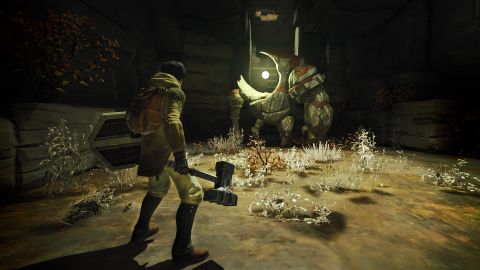
Chronos defies the common wisdom that VR is best used—and at its most immersive—in first person. Chronos also made me rethink the idea that VR needs truly new genres to shine. This is a tried-and-true action RPG in the Zelda vein, with timing-heavy combat and puzzle solving that feel more than a little familiar. But Chronos did something for me that Zelda never could. That no game I’ve ever played on a monitor or TV has ever done for me. Even when I’m utterly absorbed in a game’s world, I don’t feel like I’ve been transported inside my monitor. But that’s what it feels like to play Chronos in VR. I was there, and I didn’t want that experience to end.
NEED TO KNOW
What is it? A third-person action RPG set in an intricately connected fantasy world.
Expect to pay: $50
Developer: Gunfire Games
Publisher: Gunfire Games
Reviewed on: Core i7-4770K, 16GB RAM, GeForce GTX Titan Black
Multiplayer: N/A
Link: Official site
Chronos’s third person camera frames a series of rooms and corridors and ancient ruins from fixed positions, quietly pulling you into the scope of its environment as you control your hero with a gamepad. (Think Resident Evil’s HD Remaster for a close analogue). It’s such a simple trick, and yet the combination of Chronos’s fantastic interconnected world, evocative art and smartly placed camera angles made me feel like more of an explorer than I ever have outside of VR.
The fixed camera works surprisingly well for combat, too, with a few exceptions. On occasion I found myself too far away from the camera (or too close) to read an enemy’s attacks, but that happened rarely in the 15 hours or so it took me to finish Chronos.
Chronos hews closely to the basics of sword and sorcery RPGs, with a simple experience system and combat that relies on attack, block, roll, and parry. Developer Gunfire Games knows how to imbue combat with weight and a sense of rhythm; the Chronos team previously worked on Darksiders and Darksiders 2, and like those games, Chronos requires that you master the basic techniques of attacking, dodging and parrying, or even simple enemies will take you down. No matter how many points you put into its four stats—strength, agility, magic, and vitality—if you don’t read enemy attacks and learn when to block or dodge, you’ll die over and over again.
Dying in Chronos evokes a pang of guilt more than it does frustration.
Dying in Chronos evokes a pang of guilt more than it does frustration. Your young explorer, who starts the game as a teenager, is on a quest to the heart of a mysterious labyrinth, but the labyrinth only opens once per year. Every death ages you a year and tosses you out, though you’ll conveniently restart at the last warp crystal you encountered. In practice, this means only a few minutes lost progress, and Chronos is generous with doors that lead you back to places you’ve already been, eventually revealing the labyrinth to be a honeycomb of interconnected passageways that’s immensely satisfying to fully explore.
Every decade of deaths unlocks a new perk, like faster parrying or more health, but as my character aged through his 40s and 50s and his beard streaked with grey, I took each death harder. This affects leveling up as well. In my early years upgrading strength and agility was cheap, but as my character got older, leveling agility grew more expensive, while arcane skill points grew cheaper. Chronos could’ve done more with its aging system, but I like how understated this feature is—it never goes out of its way to point out the connection between skill points and your hero’s aging body.

A NOTE ON SCREENSHOTS
We always strive to use our own screenshots in reviews instead of publisher-provided images, but that’s tricky in VR. Thanks to the Rift’s lens system, our screenshots looked very different from what we saw with our own eyes.
The screenshots in this review came from Gunfire Games and are representative of how the game looks in VR, but with better image quality than the Rift’s screen resolution delivers.
Chronos places enemies in your path sparingly, but the timing of combat is demanding enough to make fighting even two enemies at a time challenging. Even the small goblin-like Kell Chronos throws at you first, who let out a war cry and barrel forward with knives, have two or three different attacks to choose from. Later enemies will often alternate between fast lunges, powerful swipes, and multi-hit combos, all of which are telegraphed as you learn their animations. I focused on parrying with my agile character and cursed myself almost every time a failed parry caused me to take a few hard hits to the face. I knew immediately when I’d parried too early.
My favorite enemies to fight were faster than me and had longer reach, leaping into range with brutal curved swords or thrusting at me with ornate spears. I was constantly on an adrenaline edge fighting them, dancing around attacks, dodging in close to deliver a follow-up combo, then dodging back at the right moment to avoid the retort. Chronos gives out few healing items along the way, and enemies hit hard enough to kill you in just a few attacks, especially early in the game. Coming out unscathed thanks to a perfect set of parries and dodges was consistently thrilling. In the toughest fights, this meant reading an attack, dodging a vicious fast thrust and a follow up, delivering three sword blows of my own, and stepping back out of range.
Coming out unscathed thanks to a perfect set of parries and dodges was consistently thrilling.
Exploration similarly draws from the fundamentals of past adventure games. Each region of the labyrinth hides a few key parts to find, like a jewel used to unlock a door, a gear to complete an ancient machine, a series of runes to decipher to solve a puzzle. Presentation and the influence of VR prevents these from feeling stale, even though I was disappointed by the simplicity of most of these puzzles.
The ideas in play are familiar, and the solutions rarely difficult, but each discovered object feels like a mysterious artifact of an ancient civilization, a beat in the rhythm of encountering an obstacle and then the means to overcome it. There was only one puzzle in the game I felt satisfied for solving—a particularly nasty sliding block puzzle (my weakness!)—but I still found simple pleasure in putting the right item in the right place to unlock a new section of the labyrinth.

The scope of Chronos’s environments in VR lends the puzzles, and even wandering the labyrinth, a physicality they wouldn’t have in a normal game. One of the most striking moments came when I entered an empty room with a tall staircase leading up to the second floor. The camera is usually placed on the ground level, but here it towered far above, and I was suddenly looking down on my character like a toy standing in a doorway.
VR adds tremendous scale to game environments.
An actual “whoa” escaped my mouth. It’s hard to understand until you see it, but this view reminded me of standing on a cliff in Taroko Gorge, looking at mountains surrounding me on all sides. In that space, I felt small. VR adds tremendous scale to game environments, and Chronos’s fixed camera perspective and brevity of UI (there’s no HUD, and only a menu if you press a button to pull it up) repeatedly told my brain that I was moving through this space on a level I’ve never experienced in a typical third person game.
There are bits of story and lore to pick up as you explore the labyrinth, some brief histories of its creatures, which I enjoyed finding and reading. Much of the game’s atmosphere comes from your isolation and the sense of mystery of piecing together the history of a strange land. The bit of narrative framework surrounding the labyrinth isn’t nearly as interesting and takes what ultimately feels like a pointlessly dark turn at the end—Chronos would’ve been better served by simply playing it straight and committing to its fantasy setting.
Fighting my way through that labyrinth kept me enraptured for 15 hours, and by the end all I really wanted was more. Chronos keeps things intentionally tight, with only a few weapons to find and upgrade and very little in the way of NPCs to interact with, but it’s still the longest, meatiest game made for VR that I’ve played. By the end I still enjoyed its combat and exploration, but yearned for a bolder, more complex RPG in the exact same vein. It’s a rare thing for me to be halfway through a game and already excited to play a sequel.









